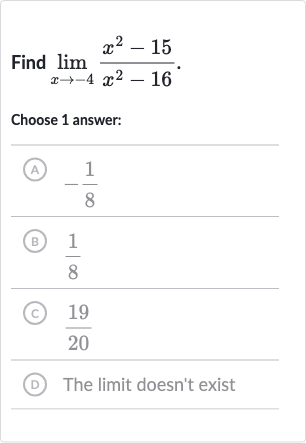Full solution
Q. Find Choose answer:(A) (B) (c) (D) The limit doesn't exist
- Identify the limit form: Identify the form of the limit.We need to find the limit of the function as approaches . Let's substitute into the function to see if we can directly evaluate the limit.This results in a division by zero, which is undefined. Therefore, we cannot directly evaluate the limit by substitution.
- Substitute : Factor the denominator and simplify if possible.The denominator is a difference of squares and can be factored as .Since we are looking for the limit as approaches , we can check if the numerator has a factor of that would cancel out the denominator's .However, the numerator does not factor with as a factor, so we cannot simplify the function by canceling out terms.
- Division by zero: Evaluate the limit using algebraic manipulation.Since we cannot simplify the function by canceling out terms, we need to use another method to evaluate the limit. We can use the fact that the function is continuous everywhere except at and (where the denominator is zero).For values of close to but not equal to , the function is defined and continuous. Therefore, we can evaluate the limit by approaching from either side.As approaches , the numerator approaches , and the denominator approaches , but since we are taking a limit, we are not actually dividing by zero.The limit of the numerator as approaches is , and the limit of the denominator as approaches is a very small number close to zero but not equal to zero. Therefore, the limit of the function as approaches is a very large number.Since the denominator is , and we are approaching , the sign of the denominator is positive (because ). Therefore, the limit is positive.The limit of the function as approaches is positive infinity.
More problems from Compare linear and exponential growth
QuestionGet tutor help
QuestionGet tutor help
QuestionGet tutor help
QuestionGet tutor help
QuestionGet tutor help
QuestionGet tutor help
QuestionGet tutor help

